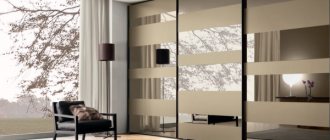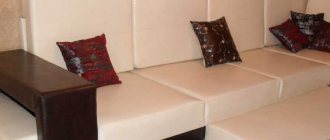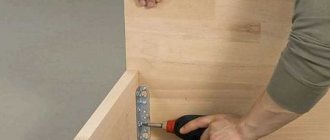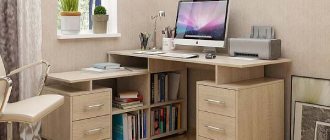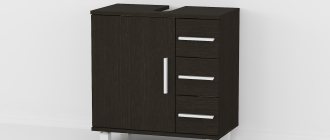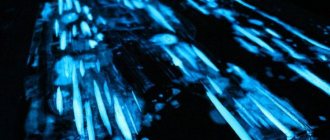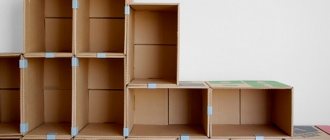Facade processing methods
To give a finished look to kitchen facades, the following coating is applied to the surface of the base:
- acrylic plastic,
- melamine film,
- enamel,
- polymer film (PVC),
- veneer.
Resistance to scratches, the likelihood of varying the color palette and the degree of difficulty in maintenance depend on the coating of kitchen facades. The parameters of plastic, film, veneer and other materials in the table below will help you decide on the coating of kitchen facades.
Material Parameters Plastic facades Advantages: practicality, long service life (up to 25 years), large selection of textures (including those imitating natural wood), resistant to water and temperature, retain their shape, do not deform. PVC coating film facades are highly durable, resistant to fading and at the same time very affordable. There are a huge number of films of any shades, with different textures, which allows you to choose a color scheme to suit any artistic design. Disadvantages: compared to plastic ones, they are least resistant to bad influences. sudden changes in humidity and temperature lead to peeling and deterioration of the film. Enamel The advantages of enamel facades: richness of colors, ease of care using household care products (except for abrasive ones), the ability to produce bent shapes. Disadvantages: high cost compared to PVC and plastic, instability in ultraviolet light and fading over time. Veneer The veneer surface is natural, which is very noticeable nearby. The veneer looks generous both in appearance and to the touch. Veneer facades are highly durable, reliable, resistant to scratches and temperatures. Even if minor damage occurs, you can disguise it by sanding. The same cannot be said about films and plastic. Even if the set is made of cheap chipboard or MDF (compared to solid wood), then veneering already makes the furniture look more solid. The naturalness and environmental friendliness of this material will always be in demand. The disadvantage of veneer is the high cost and the likelihood of loss of appearance due to the influence of humidity
Therefore, pay special attention to the presence of special moisture-repellent impregnation and treatment.
Do-it-yourself restoration of wooden furniture using retouching pencils
One of the advantages of solid wood furniture is its long service life and the possibility of its restoration, after which the items return to their original appearance. Work is carried out as necessary, depending on the defects and the degree of damage. Sometimes even minor flaws at first glance can ruin the entire appearance.
Varieties of markers for retouching scratches on wooden furniture, which consist of multi-colored quick-drying enamel
To remove minor damage in the form of abrasions and shallow scratches, you can use special markers and retouching pencils. They come in different colors and can be purchased in specialized stores. You should choose a material that is as close as possible to the main color of the product.
To restore scuffs and chips, you can purchase the following items:
- Retouching markers, which consist of multi-colored, quick-drying enamel. The composition is not afraid of the influence of detergents and when using it you can do without applying varnish.
- Alcohol pencils for retouching, allowing you to preserve the appearance of wood texture without harming the base. The pencil contains an alcohol stain, so to make the coating durable, it is better to varnish the surface.
- Texture pencils for retouching. They are used to draw the texture of wood. The thinness of the rod will help restore any contour, even in hard-to-reach places. After this, the surface is waxed or varnished.
Wooden furniture can be restored and repaired, which further extends its service life
Restoration of wooden furniture to eliminate deep scratches and chips
Deep scratches are long-lasting. A special wax will help get rid of them, after applying which the damage will practically disappear. There are a variety of wax mixtures that vary in hardness and color. If you use a transparent composition, you will need to apply enamel or tinting varnish on top.
If you need to remove deeper chips and dents, you will need a special wood putty. It is necessary to choose a product of the appropriate color. The putty is applied in several layers, after allowing the previous base to dry completely. After applying all the layers, the base is leveled with sandpaper and an additional layer of varnish is applied.
Gasoline will help remove dirt from the polished surface of wooden furniture.
You can remove dirt from the polished surface of wooden furniture using gasoline. To do this, just soak a rag in gasoline and wipe the stain. If the stain is still present after the surface has dried, the action must be repeated. After this, you need to wipe the base with a clean, dry cloth and apply denatured alcohol or linseed oil, which will help restore the damaged polish. Stains from hot objects can be eliminated with vodka or alcohol.
Wooden furniture is not only an item for functional use, but also an important element of the overall interior. For lovers of the beautiful, refined, natural and exclusive, wooden furniture is the best choice in the setting. Its price can be quite high, taking into account all the advantages, in particular strength and durability. Making household items yourself will help solve the cost issue. If you have certain skills, equipment and tools, you will only have to spend money on high-quality material.
Space materials
What else is furniture made from? Recently, in modern furniture design there has been a tendency to widely use glass, metal and plastic in the production of home furniture. This is especially true for the ultra-fashionable high-tech style. A large abundance of chrome and glossy surfaces are the distinctive features of this style.
The use of glass and metal in furniture production allows us to expand and diversify the range of products and identify different style trends. Glass is used both in the form of structural parts of furniture and as decorative and overhead elements that improve the aesthetic properties of furniture. Various types of tempered and non-tempered glass are used: transparent, frosted, tinted, painted.
When installing glass furniture in a children's room, make sure it is safe. A protective film must be applied to glass surfaces. In this case, if a child accidentally breaks, for example, the glass facades of a cabinet, this film will not allow the fragments to fall to the floor and injure the baby.
Perhaps these are the most common materials from which manufacturers offer furniture on the market today. The main thing is to remember: it doesn’t matter so much whether the material is artificial or natural. It is important that it is of high quality. If the material is produced in compliance with all hygienic requirements, it is harmless. How to find out? Easily! Request a quality certificate from manufacturers.
Companies that value their reputation, such as the Ronikon furniture factory, will provide you with all the necessary documents, and will tell you in even more detail which material is best to choose in order to produce high-quality furniture that is safe for your child.
Source: aif.ru
Types of wood boards
The cost of furniture depends on the quality of the wood taken for its manufacture. Natural wood is highly resistant to negative influences, mechanical damage, humidity and temperature changes. Solid furniture structures are made from natural wood. As for cabinet furniture, the most suitable materials for its manufacture are wood panels obtained after processing wood.
MDF
Fiberboard is a material for furniture, the creation process of which requires dried wood fibers treated with special substances that act as binders. The layer-by-layer laying of fibers resembles the weaving of a carpet in its structure.
This material in the manufacture of cabinet and modular furniture is used only after the hot pressing process and application of the finishing (decorative) melamine coating or veneer. The cost of MDF is several times higher than the price of chipboard, but in terms of its qualities (strength and wear resistance) this material is better than others.
Chipboard
Chipboard, the positive quality of which (unlike natural wood) is the absence of knots and other defects. There are no internal voids or cracks in the chipboard. In order to make this material for furniture, sawdust and shavings are mixed with glue. After this, they are pressed and, after waiting for complete drying, they are sanded. The strength of the boards is given by melamine paper or veneer.
Chipboard is widely used in the manufacture of furniture for offices, educational institutions, and public reception areas. Finished structures have high strength, moisture resistance, resistance to aggressive environments and temperature changes.
laminated chipboard
Laminated chipboard. This stove is present in every home. Furniture structures and flooring are assembled from it; it can be seen as decoration on walls and ceilings. The surface of laminated chipboard is highly durable and resistant to mechanical damage.
The coating is created by applying a laminated film, which is a type of paper-resin film created on the basis of thermosetting polymers. This coating provides the material with reliable protection and guarantees a long service life in areas with high traffic or high humidity levels. Resistance to moisture can only be ensured if the laminated surface is free of chips and scratches.
Fiberboard
This furniture material is better known as hardboard. Lightweight, durable and easy to process. Holds self-tapping screws and screws quite firmly. Used for the manufacture of back walls of cabinet furniture as cladding for wood frames. It was used in this way because of its fragility and fragility.
Properties of glass mugs
Such dishes are quite inexpensive and lend themselves perfectly to photo printing on mugs. Glass cups have other advantages:
- Glass does not emit hazardous substances and does not affect the taste of the drink in any way;
- You can pour boiling water into such dishes, because only heat-resistant glass is used for it. But to prevent the cup from cracking, you need to avoid temperature changes: do not pour boiling water into a cold mug.
The disadvantage of glass is its fragility and poor thermal insulation: tea in such containers cools quickly. But those who drink tea that is not too hot will not notice this property.
Materials for the manufacture of kitchen facades
Durable and moisture-resistant materials are used to produce kitchen furniture facades. Luxury kitchens are made from solid wood or multiplex - they are durable and look beautiful. Facades last up to 30 years and do not lose their attractiveness and environmental friendliness. Such wood species as birch, alder, aspen, oak, and larch are valued.
Economy class furniture is made from MDF or chipboard, which are affordable and practical. Surfaces are made matte or glossy: manufacturing companies offer a choice of colors and patterns to suit every taste. Kitchen facades made of chipboard or MDF are easy to care for; just wipe them with a mild detergent and a damp cloth.
Materials for the manufacture of modern kitchen furniture such as glass or metal look attractive. They fit harmoniously into minimalist and high-tech interiors, are wear-resistant, do not accumulate dust and dirt, and are protected from the formation of fungus and mold. However, such facades require careful maintenance; traces of hands and food are always visible on them.
MDF
MDF boards are made from compressed small chips. MDF is an environmentally friendly material; it does not contain toxic binder resins. Furniture made from MDF boards is suitable for furnishing kitchens where there are small children or people with allergies.
MDF does not deform due to water and steam, retains its color brightness, and does not fade when exposed to sunlight. Not only rectilinear sets are made from slabs, but also radius curved facades. Such elements look attractive and unusual.
The disadvantage for buyers of MDF furniture is its cost. The price of the products is higher than similar kitchen sets made of plastic or chipboards.
laminated chipboard
The laminated chipboard material is made from shavings and sawdust impregnated with formaldehyde resin. Fire-resistant types of laminated chipboard are used for the production of kitchen furniture. The furniture has a pleasant appearance, looks beautiful in a sunny room, and creates a feeling of celebration.
A variety of colors and textures allows you to choose furniture that best matches the overall style of the apartment. Consumers are also attracted by the low cost of the material.
However, there are also disadvantages:
- Working and dining groups made of laminated chipboard have average resistance to steam and temperature fluctuations, and over time they deform and swell due to humidity.
- During operation, furniture made of laminated chipboard releases formaldehyde into the air - substances toxic to human health. Laminated chipboard is divided into 2 categories: E1 and E2. The first category releases less formaldehyde into the air, which means it is suitable for the production of kitchen furniture. Before payment, the buyer has the right to familiarize himself with the quality certificate.
Plastic
The facades are based on MDF or chipboard boards lined with plastic. There is cold and medium pressure plastic, acrylic and sheet. The facades look presentable and require minimal maintenance. Plastic kitchens do not fade under the influence of ultraviolet rays and are thermally stable. The disadvantages include a short service life compared to wood.
Tree
To answer the question of which kitchen fronts will be the most practical and durable, just pay attention to natural wood. This material has a beneficial effect on the atmosphere and microclimate of the room, making it more comfortable
The most durable furniture species are oak and larch.
Wooden kitchen furniture is appropriate in any style. In Provence, this is a dining group and a kitchen painted white; in the loft there are massive benches and furniture with a rough texture.
However, a wooden kitchen has disadvantages:
- High price. Compared to other materials, solid wood is the most expensive.
- Special care. Twice a year, wooden surfaces are treated with wax or alkyd coatings. They will protect against moisture, mildew and mold.
What materials are the furniture made from? Chipboard, MDF, fiberboard.
Chipboards (chipboards)
Everyone knows that furniture is made from wood or its processing.
It can be solid wood, or chipboard, MDF, etc. The most common material, optimal in price and quality, is chipboard, which is based on sawmill and woodworking waste. In the manufacture of these boards, formaldehyde resins are used as a binding material during pressing.
For the first time, chipboards began to be used in the thirties of the last century in countries with poor forest resources, which is why new technologies were developed for the manufacture of furniture materials.
Today, the vast majority of materials used in the manufacture of furniture are particle boards (chipboards)
Wood-fiber boards (Fiberboard)
The manufacturing technology of fiberboard is slightly different from the well-known chipboard - it is a material that is also made by pressing wood fibers under high temperature and formed into a carpet. To obtain these fibers, wood is ground and steamed.
The raw materials for the production of fiberboard boards are also waste from sawmilling and woodworking. Fiberboard also includes hardening agents, resins, paraffin, ceresin, antiseptics, etc. Fiberboard was first used in the USA in the twenties of the last century. And this technology is still used by almost all countries of the world!
In wardrobes and hallways, fiberboard with a thickness of 3.2 to 5 mm is used. As a rule, this material is used as the back walls of furniture products and as the bottom of drawers. All bent elements are also made of medium-density fiberboard.
In the furniture industry, facades with milling or frames are made from MDF. This material is made from dried wood fibers; the manufacturing technology is also based on hot pressing and grinding after treatment with synthetic binders. MDF is an abbreviation of three words from English Medium Density Fiberboard.
MDF was first used in the sixties of the last century also in the USA. In our country, the first products made from MDF appeared at the beginning of 2000. But domestic MDF producers are not able to supply furniture factories. Therefore, factories purchase this material abroad.
Compared to chipboard and fibreboard, MDF is a more environmentally friendly and progressive material today. The cost of MDF is an order of magnitude higher than the cost of chipboard. Unlike chipboard, MDF bends and mills perfectly under production conditions, making it possible to create bent, semicircular facades. This material allows you to mill a variety of designs on facades.
The German word Span (shpan) - shavings - in Russian terminology is called veneer and means a thin sheet material, made from wood by peeling or planing and used as surface cladding or for the manufacture of plywood, chipboard or MDF.
Furniture made from veneered boards is practically no different from solid wood products. Since the cladding of the panels is a thin cut of wood. Veneer furniture is much more expensive than laminated products. Don't forget that this is organic. like an array and requires careful handling.
Finishing materials and coatings.
The modern look and color variety of furniture with or without wood texture is achieved through the use of protective and decorative coatings. The most popular are laminated and laminated boards.
Lamination is the covering of a slab with films based on papers impregnated with melamine resins using high temperatures and pressures. Laminate is resistant to scratches and chemicals. In addition, there are a huge number of colors and shades of wood-textured material.
Laminating is the covering of a wood board with a polymer film or paper-resin film with complete polycondensation of the resin and subsequent application of a layer of paint and varnish material.
The film is applied using glue. Laminated boards are usually used in economy class furniture.
The Russian furniture market is developing rapidly. More and more companies offer furniture that meets all European standards.
Source: shkafi-zet.ru
MDF furniture
This material has become much more often used in the manufacture of furniture than before. In Europe, its popularity is growing at a surprisingly fast pace. It consists of plates or slabs that are made from very fine sawdust, which are subsequently pressed using high temperatures. Such hot pressing leads to the release of lingin from the sawdust - a substance that is essentially a natural glue. As a result of this process, it is possible to obtain a fairly strong and at the same time quite soft material. Such characteristics make it possible to make decorative items, carved furniture from MDF, perform all kinds of engravings and decorate furniture with patterns.
In addition, MDF is a material with increased moisture resistance.
Advantages of MDF:
- strength;
- environmental friendliness;
- moisture resistance;
- the ability to use it in the process of making furniture with carved relief patterns.
Flaws:
- easily susceptible to mechanical damage;
- higher cost compared to the same chipboard.
Furniture using fiberboard
In the case of fiberboard (fibreboard), it is worth mentioning right away that furniture cannot be made exclusively from this one material. Typically, fiberboard is used in combination with chipboard, MDF and other materials. If you look at the back of cabinets, bedside tables or sideboards, you can see a thin, rough surface there. This surface will turn out to be fiberboard. This material is made from small wood shavings using the wet pressing method.
Advantages of fiberboard:
- strength;
- environmental friendliness;
- moisture resistance;
- affordable price;
- durability.
Disadvantages of fiberboard:
- inelasticity;
- narrow scope of application (fibreboard is used mainly in the manufacture of individual elements, for example, the back walls of drawers, etc.).
Video about what material furniture is made from
PVC furniture
Polyvinyl chloride panels have become increasingly used in the manufacture of furniture. Many people mistakenly think that such panels are harmful, toxic and unsightly. Of course, PVC can release dangerous toxic gases, but only when burned. If such a high temperature does not threaten this material, then it will be absolutely safe. Considering all the qualities of PVC, furniture made from this material will be more suitable for an office environment than a home one.
Advantages of PVC furniture:
- various shades;
- mobility;
- moisture resistance;
- resistance to low temperatures;
- easy care;
- durability;
- low cost.
Flaws:
- rigidity;
- sensitivity to fire;
- low-quality types of plastic can release harmful substances into the environment;
- low strength under strong impacts.
Natural wood furniture
What material should you choose furniture from to make it as natural as possible? Of course, made of wood! If natural wood is used in the production of furniture, then it immediately becomes elite. All elite types of furniture are made only from solid solids of hardwood - beech, oak, walnut. Of course, such furniture is considered the cleanest and safest, however, certain shortcomings can be found in it.
- aesthetics;
- durability;
- strength;
- environmental friendliness;
- elitism;
- variety of varieties and shades;
- the ability to produce thin carved parts.
Negative qualities:
- high cost;
- lack of mobility;
- heavy weight;
- sensitivity to fire, moisture, damage from various insects;
- difficulties in care;
- wooden furniture is easy to damage.
Rattan furniture
What materials are furniture made from, besides those described above? Rattan can be used to make furniture. Rattan is a vine from the tropics. Asians were the first to make furniture from this material. As a rule, such furniture can often be found in country houses and dachas. However, with the advent of many different interior styles, rattan began to confidently penetrate into city apartments.
Advantages:
- mobility;
- light weight;
- aesthetics;
Flaws:
- the need for specific care using expensive products;
- Rattan furniture is quite difficult to fit into a modern interior;
- weak resistance to fire.
What material do you prefer furniture from? Share your choice on .
Accessories
Furniture fittings can be external (handles, plugs, legs, supports) and internal (hinges, door stops and stops, closers, hooks for hanging shelves, fastening strips, staples). Products of the first group are made from materials with high decorative properties. Internal elements are made mainly of metal: steel, aluminum, various iron alloys.
Instructions for installing furniture hinges, the nuances of their adjustment
Furniture manufacturing experts divide fittings into several groups according to their technical function:
- for attaching parts to each other - guides, handles, fasteners, legs;
- rotating mechanisms - hinges, swing devices, bearings;
- transformation mechanisms - recliners, roll-out devices, seat and tabletop lifts.
High-quality modern fittings cost a lot. Its total price can be up to 15% of the cost of the furniture itself. These expenses are justified, since low-budget products quickly become unusable. As a result, the furniture itself has to be repaired, which is not always possible, since screws and self-tapping screws leave mechanical damage in the wood panels.
Guides
Pens
Fasteners
Legs
Loops
Rocking devices
Bearings
Advertisers
Lifts
Features of acrylic kitchen
Acrylic kitchens are the most popular, functional and health-safe type of kitchen at the moment. Unlike plastic, wood, PVC film and enamels, acrylic has excellent technical characteristics and the most pleasant appearance, which are an integral part of any modern kitchen. However, due to the nature of production, facades also have some disadvantages. Let's look at the pros and cons of an acrylic kitchen.
Advantages
It's worth starting with the pros, since there are more of them than the disadvantages.
Advantages:
- environmental friendliness. Perhaps this is the most important advantage of the material, since the health of loved ones and our own is of the greatest value to each of us. Acrylic is an environmentally friendly and harmless material that does not contain carcinogens, toxic resins and dangerous volatile components;
- wear resistance. Acrylic furniture has extraordinary strength and durability. This coating is very difficult to damage by mechanical stress, so falling heavy objects or sharp kitchen equipment do not pose a great danger to it. Experts say that the average service life of acrylic facades is 15-20 years, but the material can be reprocessed, so if any damage or chips occur, the furniture can be restored to its original appearance;
- resistance to humidity, temperature changes and ultraviolet radiation. In addition to external mechanical loads, the kitchen set must withstand climatic loads: high and low temperatures, as well as their sudden changes, high humidity, exposure to sunlight. Acrylic coating copes with this task more effectively than any other. Acrylic does not react to temperature changes, can withstand heat up to 160 °C, which allows it to be used near an open fire, and is resistant to excess moisture, therefore, the kitchen will never rot or mold. In addition, the material is resistant to ultraviolet radiation, that is, the color of the headset will not fade, and the room will retain its original appearance for many years;
- easy care. This advantage will please any housewife. Due to the smoothness and antistatic properties of the surface of the facades, cleaning does not require much effort and time, and can be done with a simple rag, and also, as a nice addition, dust does not settle on the furniture, and soot and grease are not absorbed into its surface;
- wide range and creative diversity. The last major advantage of an acrylic kitchen is its appearance. Glitter, specularity and a variety of color palettes have made acrylic one of the most attractive and sought-after materials all over the world. Each buyer can find the most suitable shade for their kitchen from a rich range of colors, and the reflective surface of the kitchen interior will make the room visually larger and more spacious, which is an excellent addition for owners of small homes. In addition, you can order facades with your favorite pattern or ornament to diversify and add originality to the appearance of the interior.
As can be seen from the description, acrylic is deservedly popular.
Flaws
You can't talk about the advantages without mentioning the disadvantages. Like any product, these panels have them.
The most obvious disadvantages:
What should the furniture be made of? High-quality materials – healthy child
That is why we study the labels on clothes so carefully and buy only proven, high-quality products. That's why we tell them to "dress warmly" when they go outside, and "Wash your hands before eating."
Don't forget about this rule when you buy furniture for your child. And it doesn’t matter whether this furniture is bought for a baby or a teenager, the furniture should, first of all, be safe for the child’s health.
So what do manufacturers offer furniture from today?
Modern furniture can be made from different materials. It can be solid wood, MDF, chipboard, tambourate or veneer. Less often you can find furniture made of metal, glass or plastic. And, as always, each of these materials has its pros and cons.
Basic requirements for a kitchen façade
The kitchen is a place with frequent changes in temperature and humidity; drops of water, dirt and grease can fall on various surfaces. In addition, you often have to deal with hot dishes and brightly colored foods. All this creates special requirements for the material of the kitchen facade. Among the main ones we note:
- resistance to moisture, including direct contact with drops of water, as well as exposure to high humidity and steam;
- resistance to high temperatures, since surfaces near the stove and oven heat up quite well, and contact with hot dishes is possible;
- ease of care. Kitchen facades should be easy to clean from drops of grease and dirt, fingerprints, traces of dishes, food debris, etc.;
- resistance to mold and mildew. Ideally, the material itself should not rot, and also not allow microflora to multiply;
- resistance to impacts and scratches will allow the facade to retain its original appearance for a long time;
- resistance to natural dyes. Wine, coffee, various juices, and blood from meat are easily absorbed into porous materials and are difficult to remove later. Therefore, the facade material should not be porous;
- durability;
- aesthetics. The kitchen façade should not irritate or spoil your appetite. That's the minimum. Ideally, it should fit into the interior of the kitchen in style and color, and meet the tastes and preferences of the household.
There are many requirements, but there are also a lot of materials that meet them. Facades made of wood, MDF and chipboard are actively used; metal options are considered rarer and more exclusive.
Which kitchens are better: reliable manufacturers
It is necessary to take into account not only the properties of the material, but also other factors:
- room dimensions,
- style and interior design,
- available budget,
- manufacturer.
The kitchen should match the style and create integrity and unity.
Preference should be given to well-known manufacturers, such as
:
These companies have long established themselves in the market. The furniture we produce is distinguished by its variety, quality and durability.
Source: delokuhni.ru
Which is better: plastic or film on the kitchen facade ↑
If MDF for the kitchen is the optimal basis for the facade, then difficulties always arise with the choice of the top layer. What to prefer: plastic, enamel, film? Evaluate the appearance, compare the cost, and, most importantly, determine exactly how much time you are willing to spend every day on caring for the furniture.
Advantages and disadvantages of film headsets ↑
The best combination of price, quality and aesthetics is found in film facades with an MDF base. The material is easy to care for. Easy to clean with ordinary household chemicals. The film can only be deformed under the influence of high temperature and steam. It is necessary to ensure that the sun's rays do not reach the surface from the window.
The advantage is an unlimited number of design options, the ability to individually combine colors and textures, and cover complex shapes.
Poppies on PVC film: designer kit
Matte film with a wood pattern is used to create classic sets with carved facades.
Practical surface: the matte finish does not show stains
Both film and plastic can serve as canvas for photo printing. Multi-colored drawings and photographs also have practical value: water stains are less noticeable on them than on plain glossy facades.
Bright and extraordinary kitchen: film on MDF
Designers combine several colors and textures in 2 main shades, as in this “chocolate” kitchen.
Floral print film
Design and operation of plastic headsets ↑
Plastic MDF facades look bright: rich colors, mirror shine. The material is not afraid of the sun, high temperature and humidity levels. But glossy plastic panels require regular maintenance. Fingerprints remain on the mirror surface, splashes of clean water leave stains.
Semi-matte plastic textures are more practical than glossy ones.
The most fashionable color of the season in plastic kitchen facades
Glossy plastic, even in a dark color, will make a small kitchen extraordinary and spacious.
Small set with a plastic facade
Those who love gloss will have to polish their kitchen daily until it shines.
Monochromatic set: the highlight is the shade
The latest trend in kitchen fashion: plastic in an aluminum profile.
Acid-colored plastic with aluminum frame
Painted MDF: stylish solutions for modern kitchens ↑
Unlike plastic and film, enamel fits perfectly on any surface. Painted facades require careful handling and specific care. Lacquered enamel cannot be cleaned with conventional products containing chlorine and some surfactants. Cleaning with powders is prohibited.
Gold painted kitchen: enamel on MDF
It is better not to use sponges with a hard layer. When exposed to aggressive conditions, the varnish becomes covered with a network of small scratches and the surface loses its shine. You can restore the original appearance by polishing, but the top protective layer becomes thinner during polishing. It will not be possible to carry out the procedure multiple times.
Enamel is the choice for kitchens with complex-shaped facades.
Glossy red painted set
A combination of two colors and an interesting solution for the shape of the doors: with longitudinal stripes and contrasting paint.
Anthracite and red: a successful combination of shape, color and shine
Futuristic 3D facades without external fittings. You just need to touch the door to open the cabinet. Laconic form and complex texture – a game of contrast.
Painted textured MDF panels
Airbrushing is a feature that emphasizes uniqueness. Each drawing is created only once.
Kitchen with sparkle: airbrush on enamel
Veneer and solid wood: luxury of natural wood ↑
Veneer coating is increasingly being combined with other facade decoration options. For example, a patina, enamel or varnish is applied to a veneered façade. Veneered facades are combined in one set with painted or film panels.
Patinated veneer on MDF
The veneer in a warm golden hue contrasts with the black gloss of the plastic and photo printing on the dark glass of the apron - an interesting idea.
Design project: veneer in one set with plastic and glass
Veneer in a fashionable light-colored zebrawood texture will fit perfectly into a small modern kitchen with a snow-white upper tier of cabinets.
Film and veneered MDF in one set
A little history
Until recently, every apartment had a “wall” or cabinet furniture consisting of a sideboard, cabinets, and cabinets. This set was considered an ideal option for creating a comfortable and functional room. Now “walls” have lost their popularity. Instead, they are increasingly being replaced by lightweight shelving, bedside tables, chests of drawers and other furniture elements that meet the many requirements of a modern home interior. The most important requirement is that they are multifunctional.
Cabinet furniture is usually produced serially, but it is also possible to carry out orders. It can be sold in sets or in the form of modules, that is, sections. The latter are full-fledged elements that can be used separately from each other. Cabinet furniture can be produced either according to samples from the catalog or according to the customer’s personal project.
Cabinet furniture means mobility, functionality, ease of installation and dismantling. For example, a cabinet consists of a main, intermediate and final module. If desired, it can be supplemented with many sections with one or two doors. They can swing open or fold depending on how the modules are arranged. With the help of such furniture you can decorate any room. This could be a hallway, a kitchen, a living room, an office, a bedroom, or a children’s room. You can easily select suitable furniture elements for each room.
